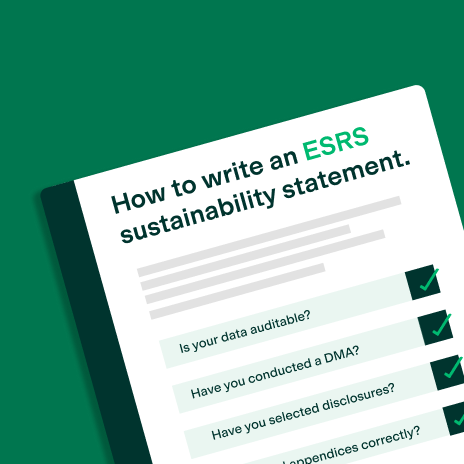ESRS compliance: How to secure internal investment and stakeholder buy-in

Get going on a process for ESRS compliance – it’s not a nice-to-have, it’s a must-have.
The EU’s Corporate Sustainability Reporting Directive (CSRD) mandates companies to integrate sustainability data into their financial reports and subject it to assurance. To implement the CSRD, the EU has developed the European Sustainability Reporting Standards (ESRS), requiring companies to provide comprehensive sustainability disclosures to investors and other key stakeholders based on the principle of double materiality, i.e. to report both on their impacts on people and the environment, and on how social and environmental issues create financial risks and opportunities for the company.
The goal of reporting companies is a resource-efficient structure and process that enables smooth and coherent non-financial reporting every year going forward. However, for many, this presents a new challenge. Data on environmental, social and governance (ESG) matters often sits within siloed systems without a standardised process for analysis and aggregation or is not available yet. It is here that a step change is needed.
Anchor the CSRD/ESRS work within your organisation
Sustainability and adherence to ESG regulations are increasingly becoming the responsibility of C-level executives, where chief sustainability officers, chief legal officers (CLOs) and chief financial officers (CFOs) are seeing the most significant expansion in responsibilities within their remit. The process of preparing for the CSRD, including the double materiality assessment and gap analysis, usually sits within the sustainability function whereas the reporting going forward is expected to increasingly fall within Finance. Assigning a dedicated Sustainability Lead for CSRD-readiness internally is becoming crucial for a company’s ability to operate.
In the new regulatory landscape, sustainability is one of few topics that encompasses and impacts almost every part of the organisation. Numerous key stakeholders throughout the business are involved as topic owners. To secure stakeholder buy-in, it’s essential to understand who will be driving the changes, identify experts to provide insights going forward and get them comfortable with the process from the get-go.
Get key stakeholders on board before the project starts
When you gain buy-in from stakeholders and senior management, you ensure your project’s success. Stakeholders need to understand not only why ESRS compliance is important for the organisation but also the sheer scope of the task and how it impacts them. What changes in ownership and roles are needed? How does it differ for the data consolidation efforts to date? Communicating the scale of the project is also crucial in driving budget conversations.
We recommend that the Sustainability Lead initially engages with more people than those actively participating in the double materiality assessment. It is essential to secure buy-in from topic owners, the department heads who are content providers in this sense, but also those who have previously had a more isolated sustainability focus and those who will be in charge of future reporting responsibilities.
Setting aside time for this is an important pre-step for things to run smoothly and at the right pace afterwards. A coherent approach reduces the risk of resource waste through unfocused efforts further on.
Embrace double materiality assessment – an essential first step
While it ultimately falls to the company to decide if a sustainability topic is material or not and justify these decisions in their reporting, this double materiality assessment is a key compliance requirement, and the ESRS provides detailed guidance on which criteria need to be met by this analysis. The double materiality assessment guides which sustainability matters are material to the company and consequently defines which underlying disclosures and data points must be reported.
We have found that those who take a shortcut directly to disclosure points and gap analysis incur costly consequences down the line. The double materiality assessment is a critical step, not only from a compliance requirement perspective but also a stakeholder management perspective. In addition to achieving an overview of the company’s ESG-related impacts, risks and opportunities, the Sustainability Lead engages with diverse individuals across the organisation. By being hands-on in the interviews with topic owners and gaining an understanding of the context and details of what’s being discussed, the lead is primed for streamlining the ongoing process in coming years.
Assign roles for the double materiality assessment
It is advisable to appoint key experts for specific sustainability matters, what we in Position Green call Responsible Area Leads. These leads can inform and build hypotheses on which topics may be considered material, but also guide the project team to a specific expert, client or bank advisor that can validate the hypothesis and provide supporting documentation. Usual functional areas covered by the responsible leads can include Finance, Risk Management, Investor Relations, Communications, Supply Chain, Sales, HR and Operations.
While department heads may be well equipped to map the higher landscape of impacts, risks and opportunities, areas relating to specific reports and data points may have been delegated to other functions, who should also be engaged in the assessment.
The dual perspectives of double materiality assessment can be challenging for internal stakeholders. Engaging external experts can help gain insights into the ESG-related impacts of the organisation, target potential areas of improvement, and develop plans and policies for enhancing sustainability performance.
How can Position Green help?
Position Green supports companies throughout their CSRD and ESRS compliance journey – from where they are today through the double materiality assessment, analysis and closing of gaps, internal competency development, and set-up of reporting and data management.
Our ESG software is designed to seamlessly integrate with existing systems, including financial software or HR systems, as well as with other ESG standards and frameworks. This enables organisations to leverage their current investments and maximise resources while benefiting from top-tier features and functionality.
Position Green’s strategic advisors bring deep industry knowledge into the process to help companies understand how they create an impact, how the risk affects them, and how to close the gaps and make sense of the regulations for their specific industry and corporate structure.

Amélie Huart
Senior Director
Position Green


